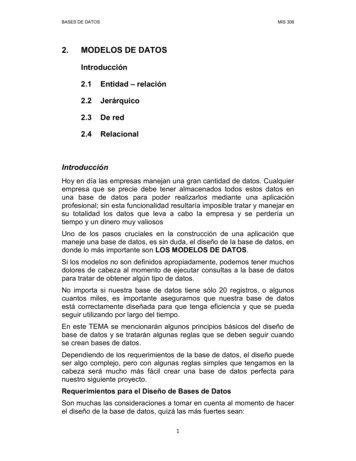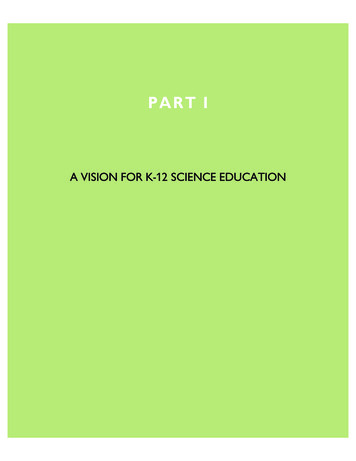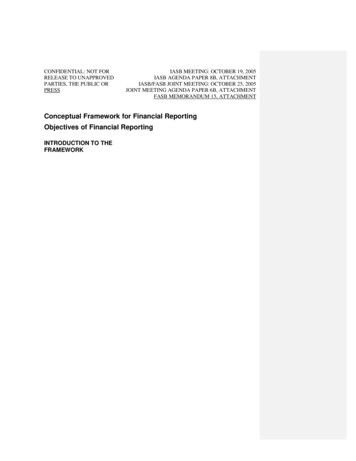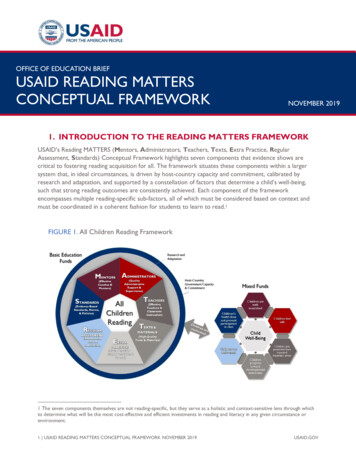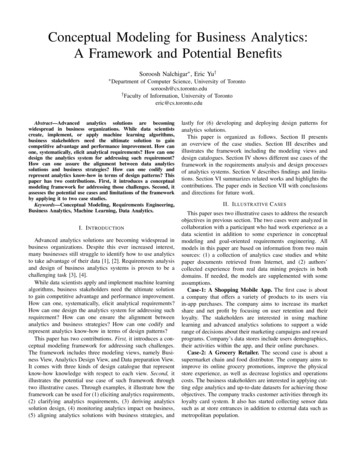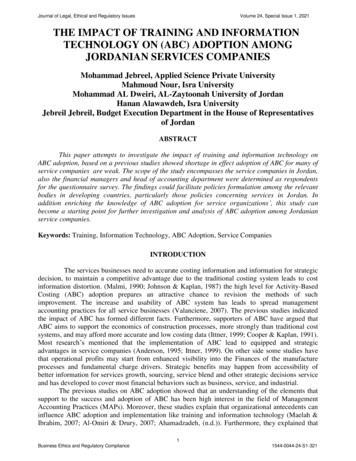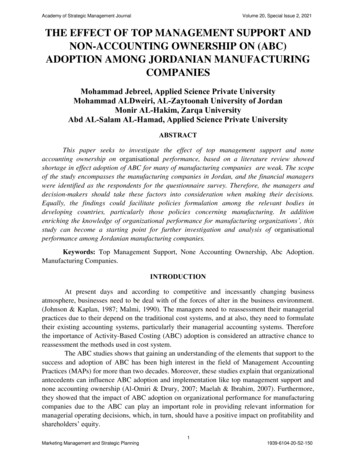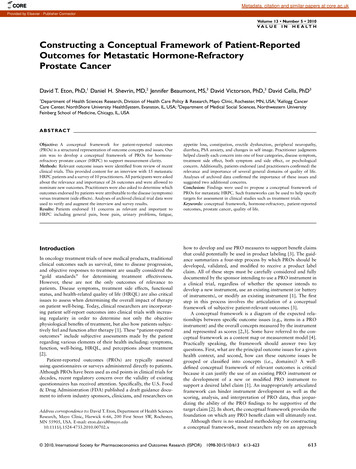
Transcription
COREMetadata, citation and similar papers at core.ac.ukProvided by Elsevier - Publisher ConnectorVolume 13 Number 5 2010VA L U E I N H E A LT HConstructing a Conceptual Framework of Patient-ReportedOutcomes for Metastatic Hormone-RefractoryProstate Cancervhe 702613.623David T. Eton, PhD,1 Daniel H. Shevrin, MD,2 Jennifer Beaumont, MS,3 David Victorson, PhD,3 David Cella, PhD31Department of Health Sciences Research, Division of Health Care Policy & Research, Mayo Clinic, Rochester, MN, USA; 2Kellogg CancerCare Center, NorthShore University HealthSystem, Evanston, IL, USA; 3Department of Medical Social Sciences, Northwestern UniversityFeinberg School of Medicine, Chicago, IL, USAA B S T R AC TObjective: A conceptual framework for patient-reported outcomes(PROs) is a structured representation of outcome concepts and issues. Ouraim was to develop a conceptual framework of PROs for hormonerefractory prostate cancer (HRPC) to support measurement clarity.Methods: Relevant outcome issues were identified from review of recentclinical trials. This provided content for an interview with 15 metastaticHRPC patients and a survey of 10 practitioners. All participants were askedabout the relevance and importance of 26 outcomes and were allowed tonominate new outcomes. Practitioners were also asked to determine whichoutcomes endorsed by patients were attributable to the disease (symptoms)versus treatment (side effects). Analyses of archived clinical trial data wereused to verify and augment the interview and survey results.Results: Patients endorsed 11 concerns as relevant and important toHRPC including general pain, bone pain, urinary problems, fatigue,appetite loss, constipation, erectile dysfunction, peripheral neuropathy,diarrhea, PSA anxiety, and changes in self image. Practitioner judgmentshelped classify each concern into one of four categories, disease symptom,treatment side effect, both symptom and side effect, or psychologicalconcern. Additionally, patients endorsed (and practitioners confirmed) therelevance and importance of several general domains of quality of life.Analyses of archived data confirmed the importance of these issues andsuggested two additional concerns.Conclusion: Findings were used to propose a conceptual framework ofPROs for metastatic HRPC. Such frameworks can be used to help specifytargets for assessment in clinical studies such as treatment trials.Keywords: conceptual framework, hormone-refractory, patient-reportedoutcomes, prostate cancer, quality of life.Introductionhow to develop and use PRO measures to support benefit claimsthat could potentially be used in product labeling [3]. The guidance summarizes a four-step process by which PROs should bedeveloped, validated, and modified to receive a product labelclaim. All of these steps must be carefully considered and fullydocumented by the sponsor intending to use a PRO instrument ina clinical trial, regardless of whether the sponsor intends todevelop a new instrument, use an existing instrument (or batteryof instruments), or modify an existing instrument [1]. The firststep in this process involves the articulation of a conceptualframework of subjective patient-relevant outcomes [3].A conceptual framework is a diagram of the expected relationships between specific outcome issues (e.g., items in a PROinstrument) and the overall concepts measured by the instrumentand represented as scores [2,3]. Some have referred to the conceptual framework as a content map or measurement model [4].Practically speaking, the framework should answer two keyquestions. First, what are the principal outcome issues for a givenhealth context, and second, how can these outcome issues begrouped or classified into concepts (i.e., domains)? A welldefined conceptual framework of relevant outcomes is criticalbecause it can justify the use of an existing PRO instrument orthe development of a new or modified PRO instrument tosupport a desired label claim [1]. An inappropriately articulatedframework can hinder instrument development as well as thescoring, analysis, and interpretation of PRO data, thus jeopardizing the ability of the PRO findings to be supportive of thetarget claim [2]. In short, the conceptual framework provides thefoundation on which any PRO benefit claim will ultimately rest.Although there is no standard methodology for constructinga conceptual framework, most researchers rely on an approachIn oncology treatment trials of new medical products, traditionalclinical outcomes such as survival, time to disease progression,and objective responses to treatment are usually considered the“gold standards” for determining treatment effectiveness.However, these are not the only outcomes of relevance topatients. Disease symptoms, treatment side effects, functionalstatus, and health-related quality of life (HRQL) are also criticalissues to assess when determining the overall impact of therapyon patient well-being. Today, clinical researchers are incorporating patient self-report outcomes into clinical trials with increasing regularity in order to determine not only the objectivephysiological benefits of treatment, but also how patients subjectively feel and function after therapy [1]. These “patient-reportedoutcomes” include subjective assessments made by the patientregarding various elements of their health including: symptoms,function, well-being, HRQL, and perceptions about treatment[2].Patient-reported outcomes (PROs) are typically assessedusing questionnaires or surveys administered directly to patients.Although PROs have been used as end points in clinical trials fordecades, recent regulatory concern over the validity of existingquestionnaires has received attention. Specifically, the U.S. Food& Drug Administration (FDA) published a draft guidance document to inform industry sponsors, clinicians, and researchers onAddress correspondence to: David T. Eton, Department of Health SciencesResearch, Mayo Clinic, Harwick 6-66, 200 First Street SW, Rochester,MN 55905, USA. E-mail: x 2010, International Society for Pharmacoeconomics and Outcomes Research (ISPOR)1098-3015/10/613613–623613
Eton et al.614that combines multiple sources of data. Literature review is oftenused to summarize relevant outcome issues germane to the healthcondition under study [4,5]. This can include identification ofdisease symptoms, side effects of current treatments, and impactson general HRQL. Reviews of the clinical treatment literaturecan also help identify existing PRO instruments that may furtherelucidate important outcomes as well as specify measures thatmight be used to assess those outcomes in a trial. Patient input isconsidered vital to the construction of a conceptual framework.Typically, focus groups or qualitative interviews are used tosolicit feedback on patients’ subjective experience of a givenhealth condition [4–6]. Input from key opinion leaders such aspractitioners and other field experts can modify and elaborate theinput of patients [4,6]. Ideally, the conceptual framework isconstructed using both qualitative and quantitative methods withreliance on multiple sources of information. The process is iterative and can evolve over time as new information about thepatient’s experience of the health condition and its treatmentbecome available [1,2,4].In support of a clinical trials’ program in hormone-refractoryprostate cancer (HRPC), we set out to build a conceptual framework of relevant outcome issues for men with this disease. Prostate cancer is the most commonly diagnosed non-skin cancer inmen and the second leading cause of cancer death [7]. Most menare initially diagnosed with early-stage or clinically localizeddisease. Treatments for clinically localized prostate cancerusually involve early intervention with surgery, radiotherapy,androgen deprivation, or observation [8]. However, almost 10%of men are initially diagnosed with advanced-stage disease, andmany others will develop advanced and metastatic diseasedespite treatment with surgery or radiotherapy [8]. To stem thespread of disease, patients with advanced prostate cancer aretypically treated with primary androgen ablation (via surgical orStep 1medical castration with or without anti-androgens). Eventually,most men will become refractory to these hormonal treatments[9]. Treatment options for men with HRPC include chemotherapy, secondary hormonal manipulation, radiotherapy (tobones), and radioisotope therapy [10]. Prior to 2005, the goal ofall of these treatments was symptom palliation, especially reliefof pain from bone metastases. This changed with the publicationof two Phase III clinical trials, demonstrating a survival benefit inHRPC patients treated with docetaxel-based chemotherapy[11,12]. In TAX 327, docetaxel-based chemotherapy alsoresulted in significant reductions in pain and improvements inoverall HRQL compared to standard mitoxantrone-based chemotherapy [11]. Although these clinical findings were supportiveof regulatory approval of docetaxel-based chemotherapy, theincreased survival benefit observed in both studies was modest( 2.5 months). Hence, today’s clinical trialists are investigatingagents that could improve upon the survival and symptom palliation benefits of docetaxel while maintaining an acceptabletoxicity profile. Developing a conceptual framework of PROswill be an important adjunct to these trials because it can helpclarify the most critical patient-relevant outcome issues to assess.The objective of this study was to derive a conceptual frameworkof PROs for HRPC using methods consistent with the FDAGuidance and current expert opinion [3,4].OverviewWe combined information extracted from the published literature with input from patients and experts along with independentverification using analyses of archival data. The flow of workappears in Figure 1. Because each step builds upon the results ofa prior step, we will discuss the methods and results of each stepseparately, leading to the final proposed conceptual framework.Initial concept ID- Literature reviewPatient input- InterviewExpert input- SurveyStep 2Compile & Analyze Patient & Expert DataCreate Preliminary Conceptual FrameworkStep 3Analyze availablearchived data ofHRPC patients- Modify frameworkPropose FinalConceptual FrameworkFigure 1 Methods overview and flow of work.
615PRO Framework for HRPCMethods of Step 1—Literature ReviewThe objective of step 1 was to identify symptoms, complications,toxicities, and HRQL issues associated with advanced HRPCand its treatment. A literature search was conducted to identifythe most recently completed randomized clinical trials in HRPC.The search was limited to those trials conducted from 2004, theyear in which the two pivotal phase III trials of docetaxel werepublished (TAX 327 and SWOG 9916) [11,12]. From this literature search, several recently conducted systematic reviews of thetreatment literature were also identified. Reviews dating from2006 were selected to focus on patient outcome issues relevant tothe most current standards of treatment.Search strategy and study eligibility. Two databases weresearched, MEDLINE and the Cochrane Register of ControlledClinical Trials, from 2004 through 2007 (note: the search andreview were commenced and completed in January, 2008). Thefollowing keywords were used in the search: (prostate cancer ORprostatic neoplasms) AND (hormone-refractory OR androgenindependent OR hormone-resistant) AND (symptom* ORquality of life OR Toxicit*) AND (random* OR clinical ORtrial). The MEDLINE search yielded a total of 259 unique citations. Although 32 citations were uncovered from the search ofthe Cochrane database, all had already been identified in theMEDLINE search. Citation abstracts were reviewed; and thecomplete article was retrieved if the study was either, 1) a randomized clinical trial (or nonrandomized, but controlled trial) ofmen treated for HRPC with at least 50 patients per treatmentarm; or 2) a prospective, uncontrolled study enrolling at least200 men with HRPC. Only studies that used PROs as outcomeswere eligible for review. For instance, studies using HRQL as apredictor of other clinical outcomes were excluded. Using thesecriteria we selected 24 studies for review of PROs such as symptoms, treatment side effects/toxicities, and HRQL domains. Wealso identified five reviews of the recent clinical treatment literature (2006–07) that referenced important data on symptoms,side effects/toxicities, and HRQL. All were structured, systematicliterature reviews of randomized trials and/or clinical studieseach led by either a formal review group [9,13,14], an outcomesmeasurement expert [15], or a physician expert [16].Results of Step 1Because the objective of this task was to identify outcome issuesthat could form the basis for interview and survey queries ofpatients and practitioners, attention was focused exclusively onextracting information about patient-relevant outcomes such assymptoms, side effects/toxicities, and HRQL. Regarding theclinical studies literature (clinical trials and large-scale prospective, observational studies), data were extracted on baseline (pretreatment) symptoms of disease, changes in symptoms andHRQL over time, and treatment side effects/toxicities. Outcomeissues were extracted for later query if: 1) they were frequentlyobserved prior to treatment (e.g., notably heightened at baselineor used as stratification criteria); 2) they were found to changeover time in multiple studies or study arms; or 3) they represented frequently occurring side effects or toxicities (e.g., anygrade toxicity occurring ⱖ50%) or were severe and noticeable(e.g., a grade 3 or 4 toxicity occurring ⱖ10%). Findings fromreviews of the treatment literature were used mainly to corroborate the findings from clinical studies; however, any salient newoutcome issues could also be highlighted for later query.PROs in clinical studies and reviews. Among the clinical studiespain was the most frequently observed symptom at baseline.Table 1 Patient-reported outcomes showing change in HRPC clinicalstudies (no. of times identified per treatment arm)Concern or domainPainProstate Cancer-specific concerns (PCS)*Global QOLEmotional functionGeneral QOL (total scores of measure—ie., FACT-P)**FatiguePhysical functionNausea/vomitingAnalgesic useFunctional well-being/role ate cancer subscale (PCS) of the FACT-P. Consists of 12 items assessing: pain-4, weightloss-1, appetite-1, masculine image-1, bowel function-1, urination problems-3 (frequency,straining, activity limitation), and erectile dysfunction-1. **FACT-P consists of subscalesmeasuring: physical, functional, social, emotional, and prostate cancer-specific concerns.Pain was heightened at baseline in 7 of 22 studies (note: twostudies were HRQL analyses from SWOG 9916) [17,18]. Morespecifically, bone pain was reportedly heightened at baseline in3 of 22 studies. In the two pivotal trials of docetaxel, TAX 327and SWOG 9916, self-reported pain was used to stratifypatients prior to randomization [11,12]. Table 1 provides frequency counts of the number of times certain PROs were foundto have changed over time (per treatment arm). Clinical reviewsof the treatment literature verified the relevance of many ofthese same PROs (including, prostate cancer-specific concerns,pain, general quality of life, physical, role, and emotional function). Additionally, constipation was reportedly improved insome trials of chemotherapy [13]. Those concerns/domains thatappear more than once in clinical studies or were highlighted inclinical reviews were marked for later query with patients andpractitioners.Side effects and toxicities in clinical studies and reviews. Treatment side effects or toxicities were selected from clinical studiesif they met at least one of the following criteria: 1) it wasobserved in any study arm at a rate ⱖ50% (any grade), OR 2) itwas severe (i.e., grade 3 or 4) and was observed in a study arm ata rate ⱖ10%. The most frequently reported side effect/toxicitiesincluded fatigue and nausea/vomiting; however, alopecia,gynecomastia, infection, pain, bone pain, and diarrhea were alsoreported more than once (see Table 2). Toxicities based on clinical chemistry (i.e., hematologic toxicities) were noted, but notfurther considered because the objective was to identify outcomeissues that rely exclusively on patient self-report.Clinical reviews of the treatment literature verified the relevance of nausea/vomiting and diarrhea with both being associated with more than one drug treatment for HRPC. A review ofthe epothilones [16] identified peripheral neuropathy (tingling inthe hands and feet) as a frequently occurring toxicity. Hence, thiswas added to the list of issues for later patient and practitionerquery. Overall, a total of 22 outcome issues were marked for laterquery including the following: fatigue, nausea, vomiting, diarrhea, constipation, other bowel problems, hair loss, breastenlargement, infections, pain (in general), bone pain, peripheralneuropathy, appetite loss, weight loss, urinary obstruction/frequency, erectile dysfunction, masculine self-image, physicalfunction, emotional distress, functional well-being, social function, and global quality of life.
Eton et al.616Table 2 Major side effects or nonhematologic toxicities identified inHRPC clinical studies (no. of times identified per treatment arm)Side effect/toxicityFatigueNausea or vomitingAlopeciaGynecomastiaInfectionPainBone painDiarrheaMusculoskeletal tox. (unspecified)Cardiovascular eventDyspneaEdemaAnorexiaHand-foot syndromeInjection site reaction“Body as a whole”FlushingCount157322222111111111Methods of Step 2—Patient Interviews andPractitioner SurveysPatient interviews. A patient was considered eligible for thisstudy if he met all of the following inclusion criteria: 1) a risingPSA while on hormonal therapy; 2) a castrate level of testosterone; and 3) experience of an anti-androgen withdrawal response(i.e., regression of tumor associated with the suspension of antiandrogen therapy). Additionally, the patient had to have at leastone of the following to be deemed eligible: a positive image onbone or CT scan (i.e., an image indicative of neoplastic spread tothe bones), a rapid PSA doubling time, or a severely elevated PSA(considered by the clinician to be indicative of HRPC). Patientsmeeting these criteria were identified by their treating oncologist(D.S.) who was caring for 45 HRPC patients during the threemonth recruitment window. All were receiving treatment atNorthShore University HealthSystem (Evanston, IL, USA). Thestudy was introduced by the oncologist during a regularfollow-up visit. Interested patients then met with a researchassistant for a more complete description of the study. To maximize the likelihood of thematic content saturation, we targeted asample size of 15 patients, a number consistent with currentrecommendations for purposive samples for qualitative interviews [19]. The 15 patients who agreed to participate weresubsequently contacted to arrange a time and place for the interview. No data were collected on patients who declined to participate. Interviews were conducted between April and June,2008 by the first author (D.E.) who has prior experience conducting one-on-one research interviews with prostate cancerpatients [20]. All patients were compensated 60 for their time.The study was reviewed and approved by the InstitutionalReview Board of NorthShore University HealthSystem (IRB No.EH-08-209). All patients provided written informed consentprior to the interview.The patient interview was divided into an open and closedended section. In the open-ended section, patients were firstasked to reflect on their experience with advanced HRPC and toidentify the most important symptoms, complications, or concerns to monitor when assessing the value of treatment for thedisease. Upon identifying each issue, patients were then asked torate the importance of the issue on a 0–10 scale (0 not important to 10 extremely important). Following completion of theopen-ended section, patients were asked about the relevance andimportance of 26 additional issues. These included the following:fatigue, nausea, vomiting, diarrhea, constipation, other bowelproblems (respondent specified), hair loss, breast enlargement,infections, general pain, bone pain, peripheral neuropathy (tingling in hands/feet), appetite loss, weight loss, urinaryobstruction/frequency, other urinary problems (respondent specified), erectile dysfunction, other sexual problems (respondentspecified), masculine self-image, PSA anxiety, physical function,emotional distress, functional well-being, social function, socialsupport, and global quality of life (QOL). These issues weredrawn from the step 1 literature review with some being furtherspecified or expanded. For instance, although not explicitly mentioned in the literature reviewed, PSA anxiety was included in theinterview protocol as a disease-specific marker of emotional distress. Furthermore, both social function (ability to participate insocial activities) and social support (existence of social relationships and the assistance provided from these relationships) wereincluded in the protocol because they are domains often rolledinto scale and total scores from commonly used PRO measures(e.g., the European Organization for Research and Treatment ofCancer’s Quality of Life Questionnaire-Core 30 [EORTC QLQC30] and the Functional Assessment of Cancer Therapy-Prostate[FACT-P]). Finally, to account for the possibility of other urinarycomplications besides frequency or obstruction and other sexualcomplications besides erectile dysfunction, we included itemstapping “other urinary problems” and “other sexual problems”and asked patients to specify. Brief definitions of the more generaldomains of function (i.e., physical function, emotional distress,functional well-being, social function, social support, andglobal quality of life) were provided to patients prior to theirjudgment of relevance and importance. These definitions wereinformed by standard descriptions of these domains (see http://www.nihpromis.org). They are provided in the appendix foundat: entary/ViH13i5 Eton.asp. For any concern endorsed as relevant,patients were subsequently asked to rate it on the 0–10 importance scale. Demographic (i.e., age, race, education) and clinicalinformation (i.e., treatment, metastasis, PSA) were also collectedby patient query and medical chart review.Practitioner surveys. A list of potential practitioner participantswas generated by the first and last author (D.E. and D.C.). Thelist represented all of the major medical specialties who treat orcare for advanced, HRPC patients (i.e., medical oncology, surgical oncology, radiation oncology, and nursing). Practitionerswere eligible if they reported having at least 3 years experiencetreating or caring for at least 100 advanced HRPC patients. Mostof these practitioners were known to the authors from priorcollaborations. Others were suggested by contacted practitionerswho lacked sufficient time to participate themselves. In total, 18practitioners were invited. Four failed to respond to multiplequeries and another four declined citing lack of time. Self-reportsurveys were electronically distributed to 10 practitioners. Thesample was purposively selected to provide diversity in discipline(i.e., medicine, nursing), specialty (i.e., medical oncology, radiation oncology, urology), and geographic region. We preferred thesurvey format over interviews to facilitate timely data capturefrom an experienced group of practitioners from different geographic regions. Completed surveys were returned to the firstauthor (D.E.) and practitioners were compensated 60 for theirtime.The practitioner survey protocol was also divided into openand closed-ended sections. Practitioners completed the openended section first, returned it, and were then sent the closedended section to complete. In the open-ended section,practitioners were first asked to reflect upon their experience
617PRO Framework for HRPCTable 3 Patient clinical characteristicsMost recent PSAPSA rising at time of interview?Metastasis?Patient-reported performance status(Eastern Cooperative Oncology Group: ECOG)Current or past 6 month chemotherapy?Current or past 6 month radiotherapy?Hormone therapy in past month?Bisphosphonate therapy in past month?Median 23.12 ng/mLRange: 1.78 to 335.00 ng/mL(note: Data missing from 2 patients)YesNoYesNoECOG 1 (some symptoms, no bed rest during day)ECOG 0 (normal activity)ECOG 2 (req. bed rest 50% of waking day)YesNoYesNoYesNoYesNotreating HRPC and provide a list of the most important symptoms, complications, or concerns to monitor when assessing thevalue of treatment for the disease. Like the patients, they alsorated the importance of each issue on their list using the 0–10(not important to extremely important) scale. Finally, practitioners were asked to judge whether each identified issue was morelikely a disease-related symptom, a treatment-related side effect,both a symptom and side effect, or neither a symptom nor sideeffect.In the closed-ended section of the survey, practitioners wereasked to judge the relevance of the 26 issues identified in step 1.For those issues endorsed as relevant to HRPC, two more determinations were made. First, the practitioner was asked to rate theimportance of the issue on the 0–10 scale. Second, the practitioner was asked to judge whether the endorsed issue was morelikely a disease-related symptom, a treatment-related side effect,both a symptom and side effect, or neither a symptom nor sideeffect. Practitioners also provided descriptive information aboutthemselves including age, gender, discipline, and specialty andexperience treating/caring for HRPC patients.Results of Step 2Patient interviews. Patients ranged in age from 50 to 93 yearswith a median age of 72.8. Most were white/Caucasian (80%) orwhite/Hispanic (13%). One African American man participated.Most were college graduates (67%); however, a few (20%) hadno more than a high school education. Most were also married(87%) and retired (67%). Clinical characteristics appear inTable 3. All patients had metastatic prostate cancer and most hadevidence of disease progression (rising PSA) at the time of theinterview. Notably, PSA had stabilized for several men by thetime of the interview, likely resulting from ongoing treatment fortheir malignancy. Most patients (80%) rated themselves as beingsymptomatic according to Eastern Cooperative Oncology Groupcriteria. Patients were receiving a variety of treatments includingchemotherapy, hormonal therapy (e.g., leuprolide, bicalutamide,goserelin), and bisphosphonate therapy.Patients identified a total of 38 complications in the openended portion of the interview. Overall, minimal coding ofresponses was necessary because, in most instances, the patients’verbatim responses were used. In the few instances where multiple responses seemed to reflect a common underlying concern,two of the authors (D.E. and D.C.) discussed and agreed upon asingle name for the concern (e.g., “fatigue” and “tiredness” were9 (60%)6 (40%)15 (100%)0 (0%)9 (60%)3 (20%)3 (20%)10 (67%)5 (33%)4 (27%)11 (73%)12 (80%)3 (20%)12 (80%)3 (20%)named “fatigue”). We checked for thematic content saturation inthe following manner. First, responses from the first 12 interviews were summarized. Next, patient responses from the lastthree interviews were compared with the results of the first 12interviews to determine whether any new themes (i.e., outcomeissues) emerged. An additional four issues emerged in the finalthree interviews (11% of the total number of issues provided bypatients). Two of these four issues were already represented in theclosed-ended portion of the interview. Hence, there was sufficientevidence to conclude that saturation had been reached after 15interviews.The 38 complications were entered into a table showing thefrequency of endorsement of each along with its mean importance rating. Two rules were articulated to select eligible complications for inclusion in a preliminary version of the conceptualframework. A complication was selected if, 1) it was recalled bymore than one patient; and 2) it had a mean importance rating ofat least 5.0 (i.e., moderately important). Table 4 displays theeight complications that met these inclusion rules (note: data onall 38 complications are available from the first author).Judgments of the 26 issues reviewed by patients in the closedended portion of the interview were also entered into a data tableof frequency and mean importance. Two rules were articulated toselect eligible complications or QOL concerns for inclusion in thepreliminary version of the conceptual framework. A complication was selected if, 1) 50% of patients endorsed it as a concernof HRPC (regardless of the mean importance score); or 2) 25%of patients endorsed it as a concern of HRPC and it had a meanimportance rating of at least 5.0 (moderately important). Theseselection thresholds are slightly more restrictive than those usedTable 4 Complications identified in open-ended section of patientinterview and eligible for inclusion in the preliminary frameworkComplicationFatigueGeneral painLeg muscle soreness/weaknessCognitive decline/memory lossPSA anxietyDiarrheaBone painDisrupted taste sensationFrequency ofendorsementMean 506.00Note. Importance rated from 0 (not important) to 10 (extremely important).
Eton et al.618Table 5 Complications/quality of life issues rated in the closed-endedsection of the patient interview and eligible for inclusion in the preliminaryframeworkComplication or QOL concernPSA anxietyFatiguePhysical functionEmotional distressUrinary problems (increasedfrequency, straining)Global QOLConstipationFunctional we
Constructing a Conceptual Framework of Patient-Reported Outcomes for Metastatic Hormone-Refractory Prostate Cancer vhe_702 613.623 DavidT. Eton, PhD,1 Daniel H. Shevrin, MD,2 Jennifer Beaumont, MS,3 David Victorson, PhD,3 David Cella, PhD3 1Department of Health Sciences Research, Division of Health Care Policy & Research, Mayo Clinic, Rochester, MN, USA; 2Kellogg Cancer



